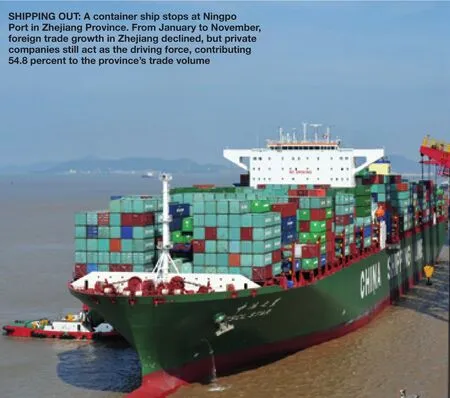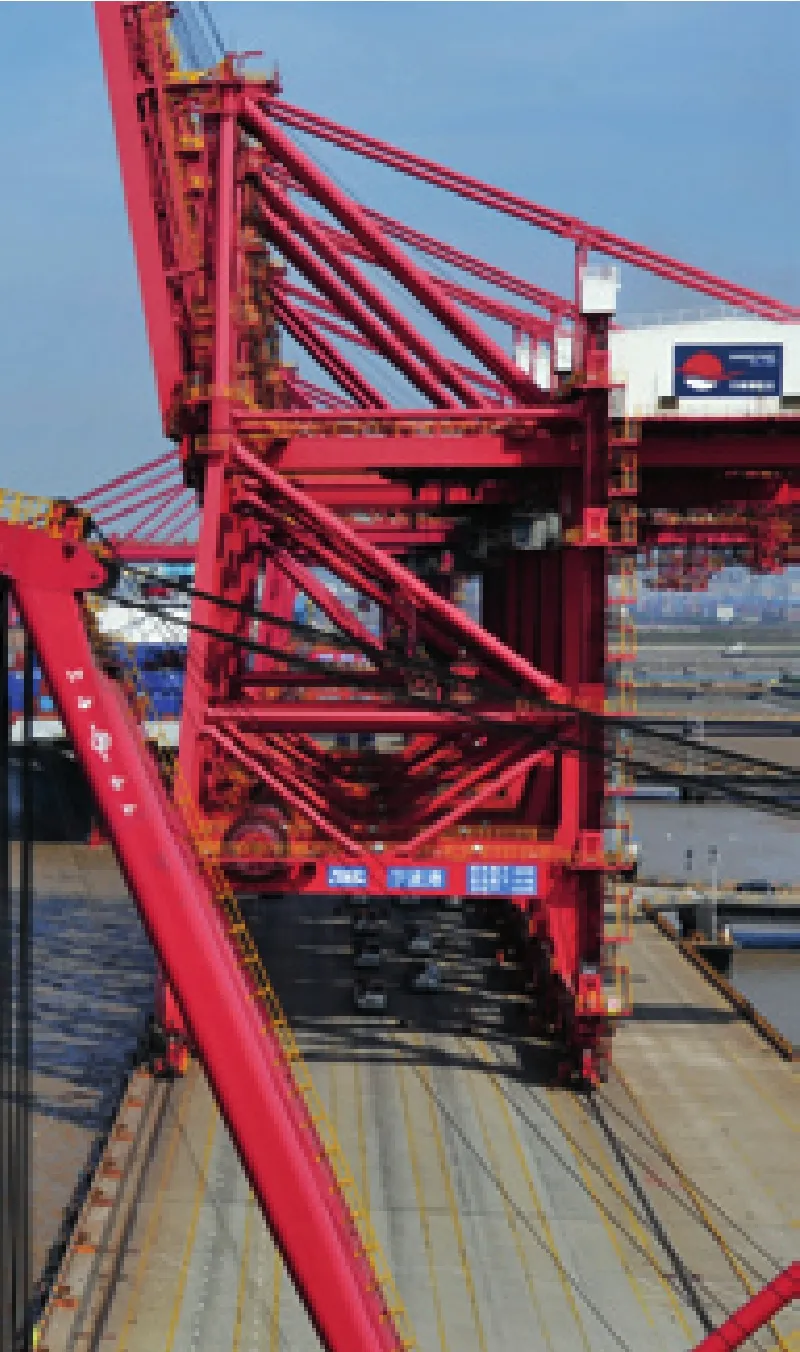Enhancing the Quality of Growth
2011-10-14ByLANXINZHEN
By LAN XINZHEN
Enhancing the Quality of Growth
By LAN XINZHEN
The Chinese economy will continue to be the spotlight for world economic growth
China’s GDP will maintain a growth rate of about 8.9 percent in 2012,said the annual economic blue book released by the Chinese Academy of Social Sciences (CASS) on December 7.Though the growth speed is lower than in 2011, it is still a relatively high rate.
Released annually since 1992, the blue book is produced by the CASS with input from scholars, government agencies,research institutes and universities by analyzing the economic landscape and government economic policies.
Chen Jiagui, Director of the CASS Economic Department, said the Chinese economy is stable with appropriate ups and downs.A growth rate of 8-9 percent is ideal to create a good macroeconomic environment for deepening the reform, controlling inflation, adjusting the economic structure and transforming the economic growth pattern.
The Chinese economy has slowed down in the last two years, arousing worries from home and abroad about the Chinese economy’s expected hard landing. Such worries are obviously unnecessary and the Chinese economy will continue to make contributions to the world economic recovery.
The situation
According to the blue book, compared with 2011, the Chinese economy will face new challenges next year. China mainly faced pressure from rapid inflation in 2011, causing the task of curbing inflation to top the list of government priorities for macro-controls. But in 2012 when the economic growth will likely slow, China needs to both stabilize the economic growth speed and further curb inflation and strengthen macro-control efforts.
Chen said thanks to the efforts in 2011,the rapidly growing prices have been curbed to some extent, but the main factors causing rapid price rises have remained unchanged.Today, prices in China are affected by the relationship between supply and demand, as well as the rising costs. Of the total, the producer price index (PPI) is mainly influenced by the relationship between supply and demand, while the consumer price index (CPI)is influenced by the rising costs.
The blue book says the CPI in 2012 will continue to rise, if only mildly. Considering rising international oil prices, China will face bigger pressures to reform its resource price scheme, so the CPI is expected to grow about 4 percent in 2012.
Next year will also be a year for China to formulate detailed measures to realize the goals for the 12th Five-Year Plan (2011-15).When readjusting the economic structure,China should also ensure economic growth is stable, which is never easy.
More importantly, the international economic situation is more and more complicated. Li Yang, Vice President of the CASS, said the Chinese Government used to think the situation in 2010 would be the most complicated, but the present situation may be more complicated, because both domestic and world economic situations are changing,with many new factors emerging, especially those that have not been anticipated.
Li thought from 2012 the world economy may remain in the doldrums for five to 10 years or even longer. Therefore “maintaining economic growth” will become a common topic for the whole world.
According to Li, among the major economies worldwide, the U.S. is not optimistic about its economy, while Europe faces a worsening situation and even needs help from the United States.
“The Euro needs rescue from the U.S.dollar for survival, which is a matter worthy of attention,” Li said.
Japan has its own mess to deal with. The Japanese economy may see growth this year instead of decline in 2010. Research suggests it will continue to see meager growth in the following two years.
Developing economies also face some problems after years of high-speed development. The economies of India, Brazil, Russia and South Africa will be in the downturn, while economies of other African and Latin American countries will not be better than this year,troubled by imbalanced internal structures and impacts of the international environment.
It’s hard for China to achieve high growth.Li said China’s foreign-related sectors are first affected by the weak world economy. In 2011 the proportion of China’s trade surplus in its GDP was lower than 3 percent, against more than 6 percent at the highest.

SHIPPING OUT: A container ship stops at NingpoPort in Zhejiang Province. From January to November,foreign trade growth in Zhejiang declined, but private companies still act as the driving force, contributing 54.8 percent to the province’s trade volume

WANG DINGCHANG
“A t the G20 Seou l Summ it held in November 2010, the other 19 countries forced China to reduce the proportion of trade surplus against its GDP to below 4 percent. At that time we were not sure about this target, so we did not promise. Now the proportion has been lower than 3 percent and we estimate it will be a longterm trend,” Li said.
Policy trend
The need for significant adjustments to macro-economic policies in 2012 is a major concern that has aroused heated arguments.The blue book thinks China should maintain the proactive fiscal policy and the moderate monetary policy.
Chen said experts and scholars are optimistic about China’s economic policies. As for the fiscal policy, since China is carrying out economic restructuring and the proportion of national debt against GDP is controllable, it is reasonable to adopt the proactive fiscal policy.
However, the government needs to strictly control the scale of fiscal deficits and the balance of national debt, particularly to strengthen supervision of local government debts. China also needs to optim ize the structure of fiscal expenditure and fully play the role of the fiscal policy in improving people’s livelihood and econom ic restructuring. The government should accelerate steps of structural tax reduction, alleviating the burden of enterprises and strengthening fiscal policies supporting small and m icro enterprises in order to promote the rapid development of small and micro enterprises.
Li Xuesong, Deputy Director of the CASS Institute of Quantitative and Technical Econom ics, said in 2012 the international economic environment w ill be more severe.Particularly, there is no effective solution for the debt crisis in the United States and Europe. Further, domestic inflation pressure is eased but there are still some uncertainties.Therefore in 2012 China should continue the proactive fiscal policy and moderate monetary policy and make slight adjustments to ensure steady economic grow th.
Li said there are three key points for China’s economic policy in 2012. First, the country should continue the proactive fiscal policy and strengthen the efforts of structural tax reduction. The government should rapidly solve the problem of double taxation that restricts the development of the service sector and formulate a fiscal policy that can promote the development of strategic emerging industries.
According to Li, at present the tax burden of small and medium-sized enterprises(SMEs) is heavy, therefore the government should expand the favored income tax policy toward some small-size and low-profi t enterprises in order to support the development of SMEs. The policy of structural tax reduction can also increase the actual income of residents, boost consumption and improve the econom ic structure.
Second, China should continue its moderate monetary policy and a reasonable grow th of credit and liquidity. “Appropriate slight adjustment has actually started, for our deposit reserve rate has been lowered,” Li said.
In 2012 China should continue to observe international econom ic trends and domestic econom ic grow th, inflation,employment and balance of international payment, w ith the aim of coordinating adoption of different monetary policy tools,promoting reasonable grow th of credit and liquidity and maintaining steady econom ic grow th. In the meantime, China should promote the market-oriented reform of the interest rate mechanism and the transfer of the renminbi exchange rate mechanism to a two-way floating one, deepen the reform and opening-up of financial institutions and support the development of financial institutions serving small and micro enterprises.
Third, China should, while maintaining steady economic grow th, deepen the reform of the resource price mechanism and accelerate strategic economic restructuring and the transformation of econom ic development pattern.According to Li, from the 12th Five-Year Plan for various industries issued in 2011, we can see that in the future China’s economic policy will focus on accelerating economic restructuring and promoting the development of strategic emerging industries.
Agriculture is still the focus for China.The CASS blue book says the econom ic policy w ill focus more on consolidating the base for agriculture, expanding input in agriculture and rural areas, ensuring the steady development of agricultural production,especially grain production, raising farmers’incomes and narrow ing the income gap between urban and rural residents.
Moreover, China w ill pay more attention to guaranteeing and improving people’s livelihoods, and more government resources w ill be put into public service sectors such as employment, social security, education,health care and affordable houses.
“A lthough the international econom ic situation is very complicated, only if the government chooses proper policies w ill the Chinese economy maintain steady grow th in 2012,” Li said.
Econom ic Fo recast
● Investment: In 2011 the nominal grow th of fixed asset investment is estimated to stand at 24.5 percent, w ith actual grow th of 16.7 percent deducting price factors.
In 2012 the investment grow th rate w ill decline, w ith nom inal and actual grow th standing at 22.8 percent and 15.4 percent respectively.
● Consum ption: In 2011 the nom inal grow th of total retail of consumer goods is estimated to be 16.7 percent, which is 1.6 percentage points lower than the previous year.The actual grow th when allow ing for price factors is 11.2 percent, 3.6 percentage points lower than the grow th in 2010.
In 2012 the total retail value of consumer goods is expected to surpass 20 trillion yuan ($3.15 trillion), w ith nom inal and actual grow th of 15.7 percent and 11.3 percent respectively.
● Foreign trade: In 2011 exports and imports are estimated to grow by 20.4 percent and 24.7 percent, respectively, year on year. The trade surplus w ill reach $160 billion,decreasing for the third consecutive year.
In 2012 the total volume of foreign trade is expected to grow less than 20 percent and the trade surplus w ill further decrease to $135 billion.(Source:China Economic Blue Book 2012)
